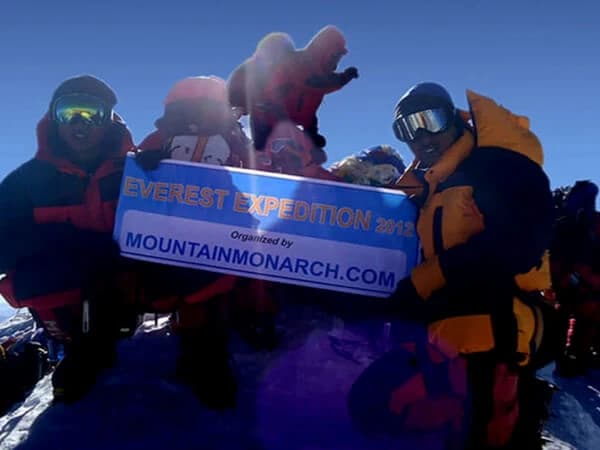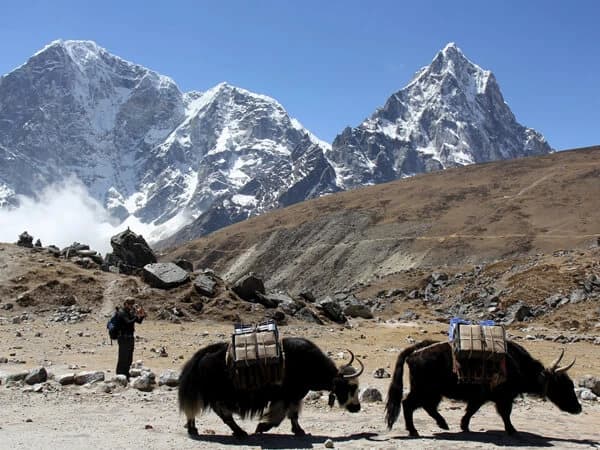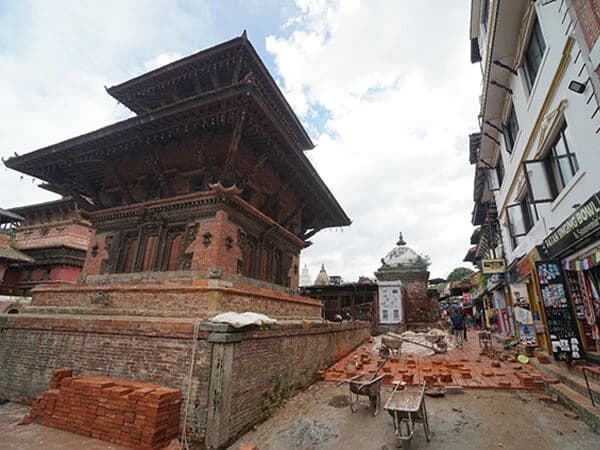Why Timing Matters for Climbing Mera Peak?
The Mera Peak climb, though it does not include technical sections and demands advanced climbing skills, including several days of high-altitude hiking in a remote and rugged Himalayan region with several steep ascents and descents, is both physically and mentally demanding. The unpredictable Himalayan weather further adds to the challenge; therefore, choosing the ideal time for Mera Peak climbing is a must.
Knowing the Mera Peak Trekking best time to be aware of the pros and cons of each trekking season in Nepal - spring, summer, autumn, and winter - is so that you can choose the time of year that calls to you the most. Each has its own set of rewards and challenges; when you know what awaits you, it maximizes the enjoyment. High-altitude trekking and climbing at the wrong time can make the ascent more dangerous, followed by a failed attempt. In short, climb Mera Peak at the best time for a safer, more scenic, and higher success rate.
What are the optimal seasons to climb Mera Peak?
The spring and autumn seasons in Nepal are widely considered the best time to climb Mera Peak. Typically spanning from the months of March to May and September to November, also called pre-monsoon and post-monsoon, these two seasons offer dry trails; the chance of rainfall and snowfall is also minimal, skies are clear, and they feature the most stable Himalayan weather conditions, perfect for alpine trekking and climbing. Below is a brief discussion on things that each prime time for journeying in the Himalayas is famous for:
How is the Mera Peak Trekking Trail in spring?
The spring season is often regarded as the ultimate ideal time to climb Mera Peak. As winter’s grip loosens, the lower valleys come alive with the fresh bloom of various species of rhododendron along with other varieties of fauna in their full glory, painting the landscape in hues of green, red, pink, and white. The temperature along the trekking route to Mera Peak is also mild, neither too cold nor too hot.
Lukla flights in comparison to the monsoon season are more reliable, and several trekking companies, such as Mountain Monarch, a locally based travel, trek, and expedition company in Nepal with more than a decade of experience, offer fixed departures. Join us in 2025 and 2026. Contact us now and reserve your seat. Views are uninterrupted, making the Mera Peak Trekking Trail a haven for photographers, nature lovers, and wildlife enthusiasts.
However, early March can still be cold at night and at higher altitudes, specifically from Khare to Mera Peak Base Camp and towards the Mera Peak Summit. In lower valleys, trekkers may encounter occasional pre-monsoon showers. Regardless, overall spring is among the Mera Peak Trekking Best Time; that is, it has increased chances of a successful summit and a deeper sense of community.
Is autumn the right time for climbing to Mera Peak in Nepal?
Yes, spring is yet another ideal time to climb Mera Peak. The weather is favorable, the skies are crystal clear, and the mountain views are unobstructed and stunning. The trekking and climbing trails are both dry and safe for navigation. Post-monsoon freshness is inviting, and aligning with two of Nepal’s grand festivals, Dashain and Tihar, cultural encounters and experiences are deeper. The chances of rain and snowstorms are also low, and so is coming across landslides and floods.
Teahouses, lodges, and guest houses are fully functioning. Well-established trails are further cleaned and dust-free, making it the right time to hike high-altitude ridges and relish in the 360-degree full exclusive views of the surrounding Himalayan peaks from Mera Peak, an unrivalled best time for trekking and climbing in Nepal. But if you are someone who prefers solitude and isolation, both autumn and spring might not be the best time for you to trek Mera Peak.
Teahouses are often overcrowded with trekkers and climbers traversing various trekking and climbing routes within the Everest region, such as the standard Everest Base Camp Trek, the adventurous Everest Three Passes Trek, the Gokyo Lakes Trek, Island Peak Climbing, Lobuche Peak Climbing, and even the Everest Expedition itself. Therefore, if you are more fond of solitude and unique experiences and do not mind some added challenges, winter can be one of the best seasons to climb Mera Peak for you.
Can you go to climb Mera Peak in winter and summer?
While both are marked as off-seasons for Himalayan treks and climbs in Nepal, winter climbing to Mera Peak might be manageable, which, however, cannot be said for Mera Peak trekking in summer seasons. For seasoned trekkers and climbers seeking a serene experience without a larger number of tourists, trekkers climb Mera Peak in the best time of winter. Typically beginning in December and lasting up to February, here’s what trekking to Mera Peak in winter and summer looks like:
When is the winter season for Mera Peak?
Featuring a winter wonderland, with almost all the landscapes above 3,000 m covered by snow, the winter season in Nepal runs from December to February. Snowfall is common and the Upper Himalayas, such as the Manaslu Circuit Trek, Annapurna Circuit Trek, Kanchenjunga Base Camp Trek, and even the Everest Base Camp Trek route, including the Mera Peak Climbing trails observe extreme cold temperatures.
But despite some days below freezing point, if prepared well, followed by the right selection of climbing gear and equipment, the sense of pristine solitude and a more raw and unspoiled Himalayan wilderness experience is simply unparalleled in winter. The risk of avalanches is also high, and short daylight hours and trip delays or cancellations can be recurring due to severe weather.
Trekkers and climbers must be aware of frostbite and other harsh weather conditions, such as whiteout and deep snow. To conclude, winter can be one of the best Mera Peak Trekking times for experienced mountaineers ready for the inherent winter season and months of demands and risks in Nepal. However, if you are a novice, sticking to the best Himalayan weather of spring and autumn is advisable.
Why is it riskier to climb Mera Peak in summer than in other seasons?
The summer season in Nepal spans from June to August. Alpine rambling, including climbing Mera Peak, is considered the least favorable and riskiest due to the monsoon time when it rains heavily, followed by high humidity and a high risk of floods and landslides. Both the trekking and climbing trails can be muddy, slippery, and at some point full of leeches, too. Often it gets cloudy, obstructing mountain views and scenery.
The weather conditions are unstable, and in the higher altitudes, snowstorms and avalanches are common during the summer/monsoon. Though crowds are very low, unless and until you are better prepared for the most adverse conditions than in other trekking seasons, climbing to Mera Peak in summer is not recommended. It is the same for both the experienced and the beginners. Instead, there are several trekking routes to the trans-Himalayan region to pursue.
If you are looking for the best summer alternatives, the Manaslu Circuit Trek, Upper Mustang Trek, Tsum Valley Trek, and Annapurna Circuit Trek are there for you. These routes and their itineraries are mostly unaffected by summer/monsoon rains and the challenges that come with them. Otherwise, in general, since summer seasons are with flight cancellations, delays, and road blockages, increasing the logistical challenges, Mera Peak climbs at this time are with risks.
What to expect from Mera Peak weather?
Weather in the high Himalayas is fickle; sunny days can change into cloudy and rainy in the blink of an eye. Temperature in the early morning, afternoon, evening, and night can vary significantly. So with the altitude. The lower valley may have milder temperatures and weather than in the higher Himalayas. Above 5,000 m, even in the peak trekking and climbing seasons of spring and autumn, it can get windy, and sudden storms are common.
As you gain elevation, the weather becomes extreme; temperatures can drop to -15 degrees Celsius to prepare for snow in the Upper Himalayas even outside winter months. To tackle it, trekkers and climbers are strongly advised to invest in appropriate gear and equipment. In case you are doing a single trip and do not want to spend a lot at Mountain Monarch, our comprehensive Mera Peak climbing cost includes climbing gear, equipment, and an oxygen cylinder standby.
This is to ensure a safe approach and your successful Mera Peak summit attempt, whether you are climbing Mera Peak in the best times of spring and autumn or cold winters. Our mountain guides are well-trained for high-altitude expeditions, including in first aid. Throughout the trip, they ensure hygienic meals and lodging. Also, closely monitoring forecasts, hire them, contact us now, and book for 2025 and 2026!
Mera Peak Temperature by Months: Which are the best months for climbing to Mera Peak?
Mera Peak is best climbed in March to May and September to November, the best Mera Peak climbing seasons of spring and autumn. The temperature is mild, from 14 to 20 degrees Celsius in May, with rhododendron blooms. Autumn, from September to November, usually ranges from 0 degrees Celsius to 12 degrees Celsius, with longer days, among which October specifically is noted for excellent visibility. In brief:
- Spring (March-May): In the month of March, daytime temperatures can reach 14-20 degrees Celsius and can drop up to -10 degrees Celsius. In April, it can go up to 20 15 degrees Celsius during the day in the valleys and near the summit, from -10 degrees Celsius to -12 degrees Celsius. Meanwhile, in the month of May, it spans from -8 to -12 degrees Celsius.
- Autumn (Septembe to November): The Mera Peak temperature by month of September is from about 0 to 12 degrees Celsius. In October, lower regions experience 5 to 15 degrees Celsius, and at higher elevations -10 to -15 degrees Celsius, significantly dropping at night. At the same time in November, daytime can go up to 1 degree Celsius, and at night, -10 degrees Celsius or lower.
- Summer/Monsoon (June to August): Usually warmer, up to 19 degrees Celsius in the lower valleys and just up to -10 0 degrees Celsius, but with frequent rain showers, prone to flight delays, cancellations, slips, mud, and leeches. The higher altitude in and around Mera Peak increased the chances of an avalanche. Not really a safe and pleasant time for climbing Mera Peak either way.
- Winter (December to February): It is the coldest season, with the summit temperature going down to -25 degrees Celsius or lower. While the skies are usually open, heavy snowfall and windstorms add much more to the challenges and can be hazardous if you are without layered clothing, sleeping bags, and other gear and equipment to keep yourself warm.
Conclusion
Mera Peak is the highest trekking peak in Nepal. Rated moderately to challenging peak climbing, more at Is Mera Peak Climb Suitable for Beginners? Mera Peak Difficulty Explained: The best time to visit Mera Peak is spring and autumn. While Mera Peak climbing in winter is also manageable, it is with extra steps of preparation and guidance from experts. Summer trekking to Mera Peak is a complete no-no. For a memorable Himalayan journey that is also safe and with a high success rate, choose to climb Mera Peak at the best time.
We have fixed departure Mera Peak Climbs in spring and Mera Peak Climbs in autumn, including in the years 2025 and 2026. Our services are unmatched, strictly by one porter per one trekker, including provision of oxygen cylinders, high-quality climbing gear and equipment, and training by a mountain leader at base camp before attempting the peak itself. This is so you have the best experience and a high summit success rate, or get it customized. Contact us now, and get a tailor-made journey just for you!





